70-460 Exam 100% Pass Study Guide: PassLeader provides the newest 70-460 vce exam dumps updated in recent days with total 94q exam questions, it is the best study materials for preparing 70-460 certification exams. PassLeader’s 70-460 94q vce or pdf dumps will offer you the latest exam questions and answers with free VCE and PDF file to download, which will help you 100% passing 70-460 exam. And PassLeader also supply the newest free version VCE Player now!
keywords: 70-460 exam,70-460 94q exam dumps,70-460 exam questions,70-460 pdf dumps,70-460 vce dumps,70-460 94q braindump,Transition Your MCITP: Business Intelligence Developer 2008 to MCSE: Business Intelligence Exam
QUESTION 16
Drag and Drop Questions
You are developing a SQL Server Reporting Services (SSRS) report that sources data from a SQL Azure database and a SQL Server Analysis Services (SSAS) cube. The cube contains a date dimension and other dimensions. The report design includes two report parameters named StartDate and FinishDate as shown in the following diagram.
The Data Type property of the parameters is set to Date/Time. The Data Type property of the parameters is set to Date/Time. You need to create the dataset based on the SSAS cube. You also need to ensure that the dataset is filtered by the existing report parameters. Which three actions should you perform in sequence? (To answer, move the appropriate actions from the list of actions to the answer area and arrange them in the correct order.)
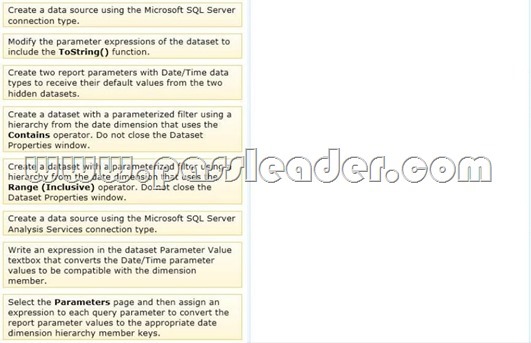
Answer: 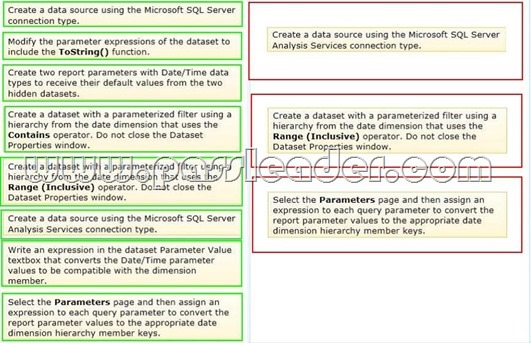
QUESTION 17
You install SQL Server Reporting Services (SSRS). You need to restore a copy of the symmetric key. Which command should you run?
A. rskeymgmt -d
B. rskeymgmt -a -f %temp%\rs.key -p Password1
C. rskeymgmt -e -f %temp%\rs. key -p Password1
D. rskeymgmt -1
Answer: B
QUESTION 18
You are designing a SQL Server Reporting Services (SSRS) report based on a SQL Server Analysis Services (SSAS) cube. The cube contains a Key Performance Indicator (KPI) to show if a salesperson’s sales are off target, slightly off target, or on target. You need to add a report item that visually displays the KPI status value as a red, yellow, or green circle. Which report item should you add?
A. Data Bar
B. Indicator
C. Radial Gauge
D. Linear Gauge
E. Sparkline
Answer: B
QUESTION 19
You are designing a SQL Server Reporting Services (SSRS) report to display vineyard names and their year-to-date (YTD) grape yield. Grape yield values are classified in three bands:
– High Yield
– Medium Yield
– Low Yield
You add a table to the report. Then you define two columns based on the fields named VineyardName and YTDGrapeYield. You need to set the color of the vineyard text to red, yellow, or blue, depending on the value of the YTD grape yield values. What should you do?
A. Use an expression for the TextDecoration property of the vineyard text box.
B. Use an expression for the Color property of the vineyard text box.
C. Add an indicator to the table.
D. Use an expression for the Font property of the vineyard text box.
E. Use an expression for the Style property of the vineyard text box.
Answer: E
QUESTION 20
You are developing a SQL Server Reporting Services (SSRS) report that renders in HTML. The report includes a dataset with fields named Description, Price, and Color. The report layout includes a table that displays product details and also includes columns named Description, Price, and Color. You need to modify the report so that users can sort products by the Price column. What should you do?
A. Add a custom action to the Price text box.
B. Set the SortExpression property to =Fields!Price.Value for the Price text box.
C. In the Expression dialog box for the Price text box, enter the =SortBy FieldslPrice.Value expression.
D. Set the SortExpression value to =Fields!Price.Description for the Price text box.
Answer: B
QUESTION 21
You are designing a SQL Server Reporting Services (SSRS) report for a bank. The bank has Automated Teller Machines (ATMs) in several regions. ATM operational data is stored in a SQL Azure database. The report must use a map to display the location and status of the ATMs as shown in the following exhibit. (Click the Exhibit button.)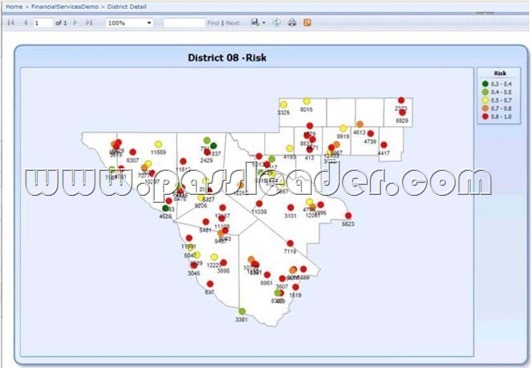
You need to ensure that the report displays only a user selected map region. Which source of spatial data should you use for the map?
A. SQL Server spatial query
B. ESRI shape file
C. Map gallery
D. Bing Maps layer
Answer: A
QUESTION 22
Drag and Drop Questions
You are developing a SQL Server Analysis Services (S5AS) cube. The cube consists of a single measure group. The measure group consists of one partition that uses MOLAP. The proactive caching policy has the following requirements:
– The cache must be updated when data is changed in the table named tbIOrders.
– Changes must be notified through the use of the XML for Analysis (XMLA) NotifyTableChange command.
You need to configure the proactive caching policy to meet the requirements. Which three actions should you perform in sequence? (To answer, move the appropriate actions from the list of actions to the answer area and arrange them in the correct order.)
Answer: 
QUESTION 23
You are developing a SQL Server Analysis Services (SSAS) cube for the sales department at your company. The sales department requires the following set of metrics:
– Unique count of customers
– Unique count of products sold
– Sum of sales
You need to ensure that the cube meets the requirements while optimizing query response time. What should you do? (Each answer presents a complete solution. Choose all that apply.)
A. Place the measures in a single measure group.
B. Place the distinct count measures in separate measure groups.
C. Use the additive measure group functions.
D. Use the semiadditive measure group functions.
E. Use the Count and Sum measure aggregation functions.
F. Use the Distinct Count and Sum measure aggregation functions.
Answer: BF
http://www.passleader.com/70-460.html
QUESTION 24
Drag and Drop Questions
You are developing a SQL Server Analysis Services (SSAS) cube. You need to reuse a Revenu measure group from a different database. In SQL Server Data Tools (SSDT), which three actions should you perform in sequence? (To answer, move the appropriate actions from the list of actions to the answer area and arrange them in the correct order.)
Answer: 
QUESTION 25
Hotspot Question
You are developing a SQL Server Analysis Services (S5AS) cube. Revenue must be compared to a goal and described by a status and a trend. Revenue, goal, status, and trend will be defined by Multidimensional Expressions (MDX) expressions. You need to add the Revenue indicator. Which tab should you select? (To answer, select the appropriate tab in the work area.)
Answer: 
QUESTION 26
Drag and Drop Questions
You are developing a SQL Server Analysis Services (SSAS) cube. You need to add a calculated member to the Customer dimension to evaluate the sum of values for the United Kingdom and the United States. Which expression should you use? (To answer, drag the appropriate expression to the answer area.)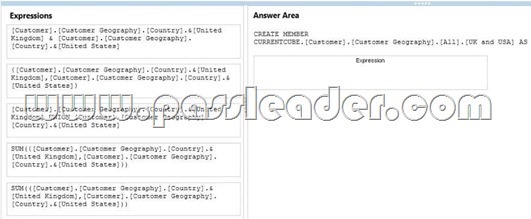
Answer: 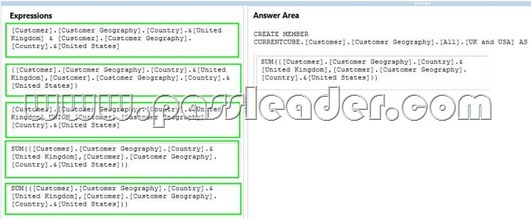
QUESTION 27
Drag and Drop Questions
You are developing a SQL Server Analysis Services (SSAS) multidimensional project. The project file includes two cubes named Finance and Operations. The project also includes a dimension named Date. The Date dimension includes two hierarchies named Fiscal and Calendar. The Date dimension has been added to both cubes. You need to disable the Fiscal hierarchy in the Operations cube without impacting other database objects. Which three actions should you perform in sequence? (To answer, move the appropriate actions from the list of actions to the answer area and arrange them in the correct order.)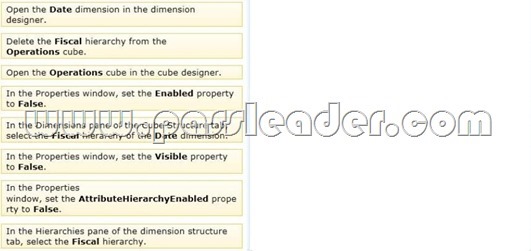
Answer: 
QUESTION 28
You are developing a SQL Server Analysis Services (SSAS) cube. The cube contains several dimensions, a local measure group, and a linked measure group. Both measure groups use MOLAP partitions. You need to write-enable one of the linked measure group partitions to support Microsoft Excel 2010 PivotTable What-If Analysis. What should you do before the partition can be write- enabled?
A. Implement the linked measure group as a local measure group.
B. Implement the local measure group as a linked measure group.
C. Set the Type property of the partition’s measure group to Forecast.
D. Set the StorageMode property of the linked measure group to Rolap.
Answer: A
QUESTION 29
You are creating a SQL Server Analysis Services (SSAS) cube. You need to create a time dimension. It must be linked to a measure group named Sales at the day granularity level. It must also be linked to a measure group named Salary at the month granularity level. What should you do?
A. Use role playing dimensions.
B. Use the Business Intelligence Wizard to define dimension intelligence.
C. Add a measure that uses the Count aggregate function to an existing measure group.
D. Add a measure that uses the DistinctCount aggregate function to an existing measure group.
E. Add a measure that uses the LastNonEmpty aggregate function. Use a regular relationship between the time dimension and the measure group.
F. Add a measure group that has one measure that uses the DistinctCount aggregate function.
G. Add a calculated measure based on an expression that counts members filtered by the Exists and NonEmpty functions.
H. Add a hidden measure that uses the Sum aggregate function. Add a calculated measure aggregating the measure along the time dimension.
I. Create several dimensions. Add each dimension to the cube.
J. Create a dimension. Then add a cube dimension and link it several times to the measure group.
K. Create a dimension. Create regular relationships between the cube dimension and the measure group. Configure the relationships to use different dimension attributes.
L. Create a dimension with one attribute hierarchy. Set the IsAggregatable property to False and then set the DefaultMember property. Use a regular relationship between the dimension and measure group.
M. Create a dimension with one attribute hierarchy. Set the IsAggregatable property to False and then set the DefaultMember property. Use a many-to-many relationship to link the dimension to the measure group.
N. Create a dimension with one attribute hierarchy. Set the ValueColumn property, set the IsAggregatable property to False, and then set the DefaultMember property. Configure the cube dimension so that it does not have a relationship with the measure group. Add a calculated measure that uses the MemberValue attribute property.
O. Create a new named calculation in the data source view to calculate a rolling sum. Add a measure that uses the Max aggregate function based on the named calculation.
Answer: K
QUESTION 30
You are creating a SQL Server Analysis Services (SSAS) multidimensional database. Users need a time dimension for:
– Dates
– Delivery dates
– Ship dates
You need to implement the minimum number of required SSAS objects. What should you do?
A. Use role playing dimensions.
B. Use the Business Intelligence Wizard to define dimension intelligence.
C. Add a measure that uses the Count aggregate function to an existing measure group.
D. Add a measure that uses the DistinctCount aggregate function to an existing measure group.
E. Add a measure that uses the LastNonEmpty aggregate function. Use a regular relationship between the time dimension and the measure group.
F. Add a measure group that has one measure that uses the DistinctCount aggregate function.
G. Add a calculated measure based on an expression that counts members filtered by the Exists and NonEmpty functions.
H. Add a hidden measure that uses the Sum aggregate function. Add a calculated measure aggregating the measure along the time dimension.
I. Create several dimensions. Add each dimension to the cube.
J. Create a dimension. Then add a cube dimension and link it several times to the measure group.
K. Create a dimension. Create regular relationships between the cube dimension and the measure group. Configure the relationships to use different dimension attributes.
L. Create a dimension with one attribute hierarchy. Set the XsAggregatable property to False and then set the DefaultMember property. Use a regular relationship between the dimension and measure group.
M. Create a dimension with one attribute hierarchy. Set the IsAggregatable property to False and then set the DefaultMember property. Use a many-to-many relationship to link the dimension to the measure group.
N. Create a dimension with one attribute hierarchy. Set the ValueColumn property, set the IsAggregatable property to False, and then set the DefaultMember property. Configure the cube dimension so that it does not have a relationship with the measure group. Add a calculated measure that uses the MemberValue attribute property.
O. Create a new named calculation in the data source view to calculate a rolling sum. Add a measure that uses the Max aggregate function based on the named calculation.
Answer: A
